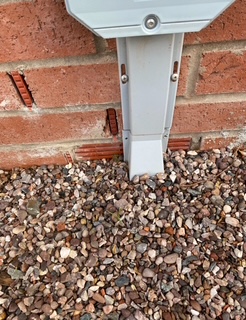What is an airbrick and why are they so important ?
- holl176
- Mar 24
- 4 min read
What Are Air Bricks?
Air bricks are specially designed perforated bricks made from clay, concrete, or plastic. They are installed in the external walls of buildings, particularly near the ground level and under suspended floors, to facilitate ventilation. These openings allow fresh air to circulate and help prevent issues caused by stagnant air and trapped moisture and also allow any gases that are present in the ground to vent away harmlessly ,
Why Are Air Bricks Important?
Proper ventilation is crucial for maintaining the structural integrity and indoor air quality of a property. Here’s why air bricks are essential:
Prevents Damp and Condensation – Without adequate ventilation, moisture can accumulate within walls and under floors, leading to dampness, mold, and rot. Air bricks help keep these areas dry by allowing constant airflow.
Protects Structural Components – Excess moisture can weaken wooden joists, floorboards, and beams, making them prone to decay. By reducing humidity levels, air bricks help preserve the structural integrity of your home.
Improves Indoor Air Quality – Poor ventilation can lead to stale air, which may contain pollutants, allergens, and excess carbon dioxide. Air bricks contribute to a healthier living environment by promoting fresh air circulation.
Prevents Pest Infestations – Dark, damp, and poorly ventilated spaces can attract pests such as woodworm, termites, and rodents. Keeping areas dry and well-aerated discourages infestations.
Common Problems with Air Bricks
Although air bricks are effective, they can become compromised due to:
Blockages – Dirt, leaves, and insect nests can clog air bricks, restricting airflow and reducing their effectiveness.
Alterations or Sealing – Some homeowners unknowingly block or cover air bricks during renovations, which eliminates essential ventilation.
Insufficient Installation – Older homes may not have enough air bricks installed, leading to inadequate ventilation and potential damp issues.
Many new homes have issues with ground levels that sometimes breech building regulations as they are too high in relation to the air brick ,like wise some setting out errors occur where an air brick can be covered by an incoming service which inhibits the air bricks function .
What Are Air Bricks?
Air bricks are specially designed perforated bricks made from clay, concrete, or plastic. They are installed in the external walls of buildings, particularly near the ground level and under suspended floors, to facilitate ventilation. These openings allow fresh air to circulate and help prevent issues caused by stagnant air and trapped moisture and also allow any gases that are present in the ground to vent away harmlessly ,
Why Are Air Bricks Important?
Proper ventilation is crucial for maintaining the structural integrity and indoor air quality of a property. Here’s why air bricks are essential:
Prevents Damp and Condensation – Without adequate ventilation, moisture can accumulate within walls and under floors, leading to dampness, mold, and rot. Air bricks help keep these areas dry by allowing constant airflow.
Protects Structural Components – Excess moisture can weaken wooden joists, floorboards, and beams, making them prone to decay. By reducing humidity levels, air bricks help preserve the structural integrity of your home.
Improves Indoor Air Quality – Poor ventilation can lead to stale air, which may contain pollutants, allergens, and excess carbon dioxide. Air bricks contribute to a healthier living environment by promoting fresh air circulation.
Prevents Pest Infestations – Dark, damp, and poorly ventilated spaces can attract pests such as woodworm, termites, and rodents. Keeping areas dry and well-aerated discourages infestations.
Common Problems with Air Bricks
Although air bricks are effective, they can become compromised due to:
Blockages – Dirt, leaves, and insect nests can clog air bricks, restricting airflow and reducing their effectiveness.
Alterations or Sealing – Some homeowners unknowingly block or cover air bricks during renovations, which eliminates essential ventilation.
Insufficient Installation – Older homes may not have enough air bricks installed, leading to inadequate ventilation and potential damp issues.
How to Maintain Air Bricks
To keep your air bricks functioning properly:
Regular Inspections – Check your air bricks periodically to ensure they are free from blockages and working effectively.
Keep Them Clear – Avoid covering air bricks with soil, paint, or other materials that could obstruct airflow.
Install Mesh Covers – If pests are a concern, mesh covers can be fitted over air bricks to prevent insects and rodents from entering while still allowing air to pass through.
Consult a Professional – If you suspect poor ventilation in your home, a professional inspection can help determine whether additional air bricks are needed or if existing ones require maintenance.
Conclusion
Air bricks are a simple yet essential feature of a well-ventilated home. They help prevent dampness, protect structural elements, and promote healthy indoor air quality. Regular maintenance and proper placement ensure they continue to function effectively. If you need expert advice or an inspection to assess your home’s ventilation, contact SnagCheck Solutions today!
How to Maintain Air Bricks
To keep your air bricks functioning properly:
Regular Inspections – Check your air bricks periodically to ensure they are free from blockages and working effectively.
Keep Them Clear – Avoid covering air bricks with soil, paint, or other materials that could obstruct airflow.
Install Mesh Covers – If pests are a concern, mesh covers can be fitted over air bricks to prevent insects and rodents from entering while still allowing air to pass through.
Consult a Professional – If you suspect poor ventilation in your home, a professional inspection can help determine whether additional air bricks are needed or if existing ones require maintenance.
Conclusion
Air bricks are a simple yet essential feature of a well-ventilated home. They help prevent dampness, protect structural elements, and promote healthy indoor air quality. Regular maintenance and proper placement ensure they continue to function effectively. If you need expert advice or an inspection to assess your home’s ventilation, contact SnagCheck Solutions today!
_edited.png)



Comments